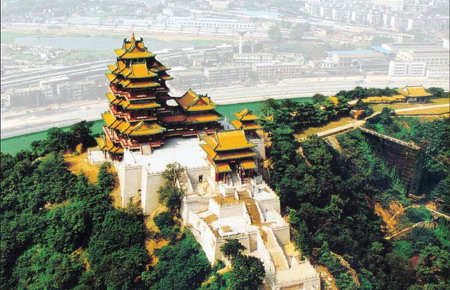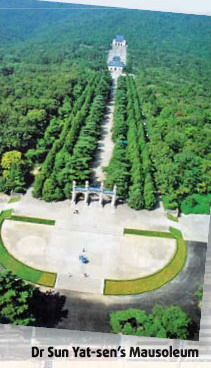
Yuejiang Lou Tower, Nanjing, Jiangsu province Courtesy photos.
Just 300 km west of Shanghai, one of China's four ancient capitals, expo visitors won't be far from Nanjing, the city long popularized by Dr Sun Yat-Sen.
Gazing out onto the Nanjing horizon, the Father of modern China used to say it was difficult to find another city like it. He described it as wonderful, with mountains, lakes and plains all around.
Though his presence in Nanjing has not been forgotten, the city's contemporary and historical significance extends far beyond the patronage of the 20th century revolutionary and politician.
The first emperor of the Ming Dynasty (1368-1644), Zhu Yuanzhang, rebuilt the city and made it the nation's capital in 1368. Later his son Zhu Di, the third emperor of Ming, relocated the capital to Beijing in the early 1400s to further strengthen the country's northern borders.

It last served as the capital in the Republic of China (1911-1949), when this role was once again ceded to Beijing. But Nanjing's storied past has left the city with a rich legacy of ancient sites and artifacts.
Sites from the Republic of China period:
Dr Sun Yat-sen's Mausoleum (中山陵)
This was built in 1926 in honor of Dr Sun Yat-Sen (1866-1925). Sun led the rebellion against the Qing government, which resulted in the 1911 revolution that put an end to the feudal system in China. Situated at the foot of the south gate to Purple Mountain, it has become a must-see destination for visitors to Nanjing.
Presidential Palace(总统府)
It housed the office of the president of the Republic of China. The building now serves as the China Modern History Museum.
Nanjing Massacre Memorial Hall (南京大屠杀纪念馆)
The memorial hall commemorates those killed in the Nanjing Massacre by the Japanese army in and around the former capital. After the city fell to the Imperial Japanese Army on Dec 13, 1937, troops relocated to Nanjing's southwestern corner of Jiangdongmen. It neighbors another site where thousands of bodies were buried, called the "Pit of Ten Thousand Corpses".
Ming Dynasty cultural attractions:
Xiaoling Tomb of Ming Dynasty (明孝陵)
Resting at the foot of Purple Mountain, the tomb marks the final resting place of Emperor Zhu Yuanzhang and Empress Ma. One of China's largest imperial tombs, the site dates back some 600 years and is a UNESCO World Cultural Heritage site.
The City Wall of Nanjing (明城墙)
This was designed by Emperor Zhu Yuanzhang after founding the Ming Dynasty and establishing Nanjing as the capital six centuries ago. In order to consolidate his sovereignty and protect the city from invaders, he adopted the suggestions of his advisor Zhu Sheng to build a higher city wall. The construction took 21 years and involved 200,000 workers, who together moved 7 million cubic meters of dirt and materials.

